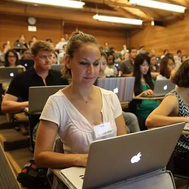Learn to Code
Berkeley Coding Boot Camp equips students with the key skills for full-stack web development through dynamic classes.
Why Get Hands-On Training at Berkeley?
Berkeley Boot Camps equip you with the essential skills to help guide you down a path to success. With strategically engineered curricula, face-to-face interaction, and knowledgeable instructors, you’ll receive a comprehensive learning experience.
Berkeley Extension Certificate of Completion Overview
- Students tap into Berkeley Boot Camps’ extensive career services and student support.
- Our programs offer a part-time schedule, allowing you to advance your skills without leaving work.
- You will receive a Certificate of Completion from Berkeley Extension.
*The material covered in these courses is subject to change due to market demand.
Class Curriculum Options
Our boot camps cover the most in-demand skills across:
These programs are offered through the UC Berkeley Extension in collaboration with edX.
About edX
edX, part of 2U Inc., works with respected universities and organizations to deliver innovative, skills-based training to a community of over 45 million learners around the world to support them at every stage of their lives and careers. edX delivers boot camps through an immersive learning experience with expert services and valuable resources. As of 2021, graduates have been hired by 6,700+ companies, including more than 62% of the Fortune 100.

What You Will Learn
- Whether you choose to dive into web development, UX/UI, data analytics, cybersecurity, or digital marketing students will learn the key skills to make their mark in the industry.
- Students will gain access to career services including mock interviews, portfolio reviews, 1:1 coaching, soft-skills training, and more to equip them for success in the job search.
- Students will take part in experiential learning opportunities, providing access to new employment possibilities.
What Graduates Receive
- Benefit from a robust set of professional development services to prepare you for success as you work to advance or change careers.
- A certificate of completion from Berkeley Extension, showcasing your achievements to potential employers.
- First-hand experience and a strong portfolio of applications and projects to display your proficiency.

*Apple and the Apple logo are trademarks of Apple Inc., registered in the U.S. and other countries.
 Live Chat
Live Chat